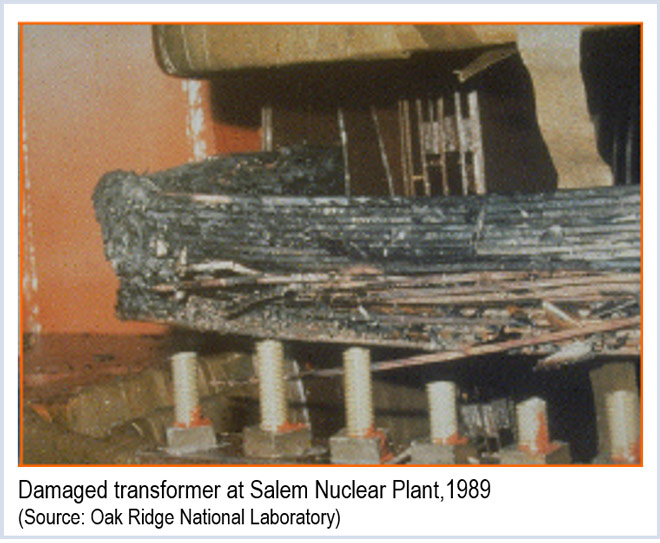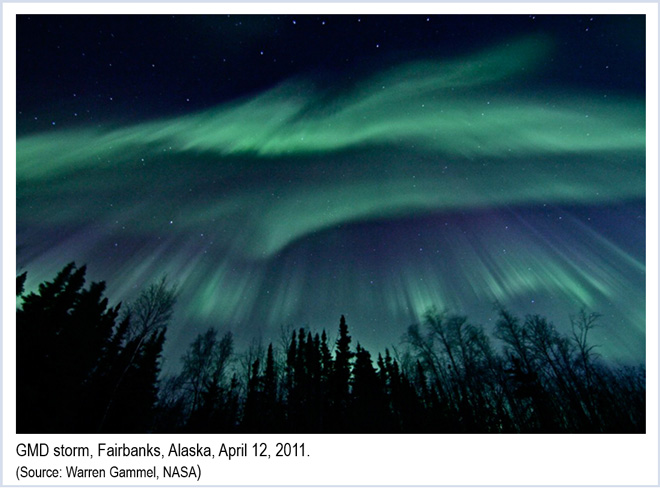By Rich Heidorn Jr.
WASHINGTON — The Federal Energy Regulatory Commission on Thursday gave preliminary approval to the second stage of its reliability standard to protect the grid from geomagnetic disturbances.
The commission’s Notice of Proposed Rulemaking (NOPR) would require grid operators to assess the vulnerability of their systems to a “benchmark” GMD event, which the North American Electric Reliability Corp. defined as a one-in-100-year occurrence. The standard (TPL-007-1, Transmission System Planned Performance for Geomagnetic Disturbance Events) would require planning coordinators and transmission planners to conduct the vulnerability assessments every five years. Entities that don’t meet performance requirements based on the assessments would be required to develop corrective plans to bring them into compliance (RM15-11).
NERC said mitigating strategies could include installation of hardware such as geomagnetically induced current (GIC) blocking or monitoring devices, equipment upgrades, training and operating procedures.
GMDs caused by solar storms are “high impact, low frequency” events. While the probability of a severe disturbance is low, it could have a severe impact on the grid, resulting in widespread blackouts and damage to equipment that could result in sustained system outages, FERC said.
Developing a GMD standard is “difficult work because we are working on a reliability threat that is not fully understood and as to which actual data are not readily and consistently available,” Commissioner Cheryl LaFleur said.
FERC ordered NERC to make changes to the proposed standard, including refining its definition of the benchmark event; requiring installation of monitoring equipment where there are gaps; and setting deadlines for completion of corrective actions. It also said it was considering shortening NERC’s proposed five-year period for full compliance.
Benchmark Event

The commission said it was concerned with NERC’s “heavy reliance” on spatial averaging — averaging impacts based on a square area 500 km in width — for the definition of the benchmark event.
“The geoelectric field values used to conduct GMD vulnerability assessments and thermal impact assessments should reflect the real-world impact of a GMD event on the bulk power system and its components,” FERC wrote. “A GMD event will have a peak value in one or more location(s), and the amplitude will decline over distance from the peak. Only applying a spatially averaged geoelectric field value across an entire planning area would distort this complexity and could underestimate the contributions caused by damage to or misoperation of bulk-power-system components to the system-wide impact of a GMD event within a planning area.
“However, imputing the highest peak geoelectric field value in a planning area to the entire planning area may incorrectly overestimate GMD impacts. Neither approach, in our view, produces an optimal solution that captures physical reality.”
As an alternative, FERC said NERC could require entities to conduct GMD vulnerability assessments and transformer thermal impact assessment using both the spatially averaged reference peak geoelectric field value (8 volts per kilometer) and the peak geoelectric field value of 20 V/km as identified in NERC’s 2012 GMD report (“Special Reliability Assessment Interim Report: Effects of Geomagnetic Disturbances on the Bulk Power System”). Entities would be required to take corrective actions, using engineering judgment, based on the results of both assessments.
“That is, the applicable entity would not always be required to mitigate to the level of risk identified by the non-spatially averaged analysis,” FERC said. “Instead, the selection of mitigation would reflect the range of risks bounded by the two analyses and be based on engineering judgment within this range, considering all relevant information.”
Defining the benchmark event is essential to the standard, LaFleur said, “because if you don’t get the benchmark right, you’re not protecting against the right thing.”
Transformers

The commission also ordered NERC to answer why it would not require qualifying transformers to be assessed for thermal impacts using the “maximum GIC-producing orientation,” saying it was concerned this could underestimate the impact of a benchmark GMD event.
“These concerns reflect in part the difficulty of replacing large transformers quickly, as reflected in studies, such as an April 2014 report by the Department of Energy that highlighted the reliance in the United States on foreign suppliers for large transformers,” FERC wrote.
LaFleur called for a strategy to allow quicker replacement of damaged transformers. “Those types of efforts will not just help the grid in its resilience to solar storms but against other risks such as physical security, cyber threats and major storms of all types,” she said.
Monitoring Devices
The commission said it also intends to change the standard to require installation of GIC monitors and magnetometers to fill any gaps in existing monitoring networks to ensure more complete data for planning and operational needs.
“To be clear, we are not proposing that every transformer would need its own GIC monitor or that every entity would need its own magnetometer,” FERC said. “Instead, we are proposing the installation and collection of data from GIC monitors and magnetometers in enough locations to provide adequate analytical validation and situational awareness.”
LaFleur noted that monitoring equipment is more widely available in other parts of the world than in the U.S. (NERC’s standard drafting team used field measurements from the magnetometer chain in Northern Europe in defining the benchmark event.) “That should not be the case,” she said.
The commission invited comment on whether it should adopt a policy governing recovery of the costs of the monitoring equipment.
‘Scaling’ Factor
The commission asked for comment on whether the impact of the “scaling” factor used in the benchmark GMD event definition to account for differences in geomagnetic latitude should be reduced. It noted studies indicating that GMD events “could have pronounced effect on lower geomagnetic latitudes.” For example, 12 transformers were reportedly damaged and taken out of service as a result of a 2003 GMD event in South Africa at -40 degrees magnetic latitude.
Deadlines
FERC also was dissatisfied that the proposed standard did not establish deadlines for developing or implementing corrective action plans. It said it plans to require corrective action plans to be developed within one year of the completion of the vulnerability assessment.
The commission also asked for comment on whether NERC’s proposed five-year implementation period could be shortened. NERC proposes a phased, five-year implementation period to allow time for entities to develop the required models, conduct vulnerability assessments and develop corrective action plans.
Comments on the NOPR are due 60 days after publication in the Federal Register.




